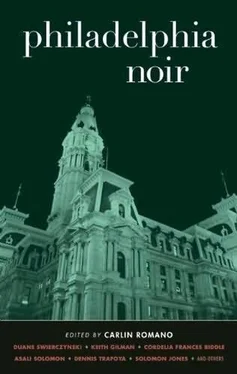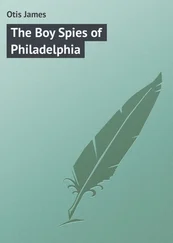“Yeah,” she said. “You’s expected. Go t’ru the lobby and where it says Lounge, head downstairs. Make a right and you’ll see another sign says, Artistes . Walk t’ru that and it’s the first door. Don’t talk to none of the patrons.”
Fin did as instructed. He walked quickly past the few customers milling about, waiting for the eleven o’clock matinee. When he got to the bottom of the steps he spotted the sign and opened the heavy iron door.
The first thing he saw in the corridor was a rat. It was dressed in what looked like red and gold silk. Almost by instinct, Finlayson jumped toward it. In the old days before he could afford traps, he caught hundreds of rats with his bare hands. Terrified, the rodent scurried through the first door on the left. Fin followed it into what appeared to be a dingy dressing room, just in time to watch it vault into the lap of a man sitting in an old caned chair.
Had he been standing, the guy probably would have measured only five-three or -four, but he had the confident air of a man twice his size. He wore a splendid suit of brown gabardine intersected with thick chalk stripes. His pale blue waistcoat was of silk floral brocade and his dark blue necktie was stuck with a good-sized sapphire. Black patent leather shoes peeked out from gray buttoned spats and his left hand rested on a silver-headed cane. Sitting on his shoulder, his arm, both his thighs, and the crown of his cream-colored Stetson were rats; each one attired similarly to the first, in shining silks of multiple colors. On closer inspection Finlayson noticed that every tiny outfit bore a number on its back.
“Ah, thank you for coming. I see you’ve already met Commodore Dutch. My name is Professor Alois Swain. If you are indeed Mr. Finlayson, then I am the one who sent for you.”
Commodore Dutch peeked out from beneath Swain’s jacket and then turned and ducked inside.
“You, sir, come highly recommended,” Swain continued. “I have been told in every saloon along this fine thoroughfare that you are Philadelphia’s finest rat man.”
“Thanks, mister, ” Finlayson said, “but it looks like you’re doing pretty well along that line.”
Swain frowned. “As of now, yes. But these few little fellows may not always be sufficient for the daily practice of my art.”
“Art? What, do you draw them or something?”
Swain laughed. “No, Mr. Finlayson, I am not that kind of artist. But even though I do not sculpt or paint, the adage remains true-one picture is worth a thousand words. So if you will be kind enough to accompany me onto the spacious stage of the Hippodrome, I will be only too happy to illustrate for you that which has made me and my little charges a household name amongst those who demand the unusual in their entertainment.”
Fin nodded and Swain rose from his chair. As he did, the gaily dressed rats scampered up his suit and onto his shoulders and arms. They clung with their claws to his back and one even dangled by its teeth from his tie. Finlayson could no longer see Commodore Dutch and guessed that he had taken refuge in one of the professor’s interior pockets.
Fin could hardly see through the gloom of the theater’s wing. He could hear grit crush beneath his boots as he followed Swain through a long black corridor. When they passed through an archway the professor flipped a large switch attached to a gun-metal box. The stage illuminated.
“Electricity,” the professor said. “The greatest boon to the performer since the theatrical brothel.”
Finlayson squinted at the sudden brightness and looked out at the many rows of worn seats. He was amazed at the sheer size of the auditorium and the grandeur of its pilasters and carvings. Women’s heads, men’s heads, and the heads of various animals were sprinkled across the two long balconies, and the stained carpet was in the pattern of a fleur-de-lis . In the far corner of the orchestra section a man was snoring in his seat. Fin recognized him as Stewie Barnes, the fry cook at Bolc’s Tavern. If he knew anything about Stewie, the guy had been here all night. Fin didn’t blame him for wanting to sleep in such a magnificent place.
Swain took Finlayson by the arm and led him to the center of the stage. There, beneath a huge canvas cover, sat an enormous object, flat on the sides and top. Swain grabbed the cover and with a single yank, pulled it to the floor.
As if on cue, the rats jumped from his arms and shoulders and on to what looked for all the world like a miniature version of a racetrack. It was oval, had a flocked “lawn” at its center, and was surrounded by tiny banners representing many nations. In the middle of the greenery and largest of all was an American flag, stiffened by glue into an eternal wave.
Swain reached beneath the track and began to remove a series of small wooden cages, six in all. From each, he produced a large cat. Like the rodents, they were bedecked in silks of varying color and number. On their backs were tiny leather replicas of English saddles. At the appearance of the cats, the rats each took up positions equidistant around the ring and stood on their hind legs.
One by one, Swain placed the cats in the center of the ring; then he snapped his fingers.
At the sound, each rat ran for the cat whose colors and number matched its own and leaped into the saddle. Swain snapped again and the cats began to race around the track in single file. After a few moments the professor clapped his hands and the cats turned toward the center of the ring. They zoomed past each other at top speed and then began running around the track again, now occupying each other’s positions. Swain clapped twice and the cats reared up. As they did, each rat leaned in toward the neck of its mount like a cowboy whooping it up on a western plain.
Swain struck the side of the track with his fist and the rats dismounted, returning to their original positions. The cats turned toward the little grass “lawn,” bunched together, and lay down, stock-still. The professor turned to his guest and grinned.
“It’s better with an orchestra.”
Finlayson stood quiet and amazed.
“I see you cannot speak,” Swain said. “Your reaction is a common one and typical of those who first experience our little exhibition. It has taken me many years to produce the zoological marvel you have just witnessed. As a result, we have topped the bill across this great land and in the capitals of Europe. I daresay that nowhere in the world is there an amusement remotely similar to Swain’s Rats and Cats.”
Fin tried to speak but his mouth was dry. Swain took a pitcher of water from a nearby stand and poured it into a thumb-marked glass. The ratcatcher took a long draught and wiped his mouth on his dirty sleeve.
“What’s this got to do with me?”
Swain’s brow knitted tightly. “Way back when, I had time to haunt the wharfs and alleys, seeking out the finest specimens. I found number six there, Romulus, in an infested theater in Brooklyn when he frightened Miss Fanny Brice into leaping on to the nearest chair.”
He reached beneath the platform again. From a large paper bag, he produced several handfuls of dried corn and sprinkled it on the floor. Immediately the rats leaped from the platform and began to gorge themselves. The cats remained in place.
“As an expert, you likely know that, even with the finest of care, the lifespan of Rattus norvegicus rarely exceeds four years, and I am far too occupied with travel and performance and training to seek out new members of my cast. Like the rest of my small charges, Romulus is aging, and in a year, perhaps two, certainly by 1915, he and his colleagues will enter our Lord’s own sewers. This, sir, as they say, is where you come in.”
Читать дальше












